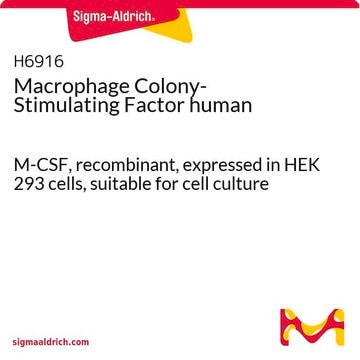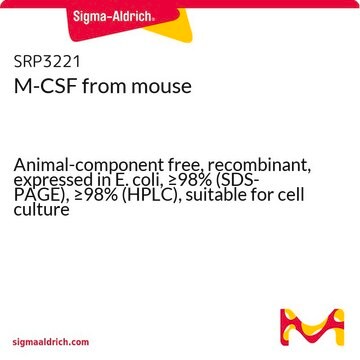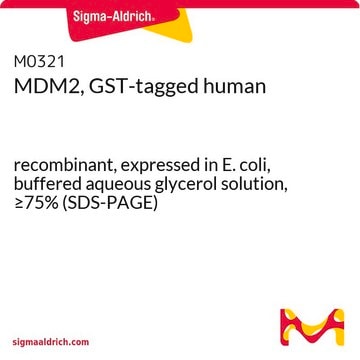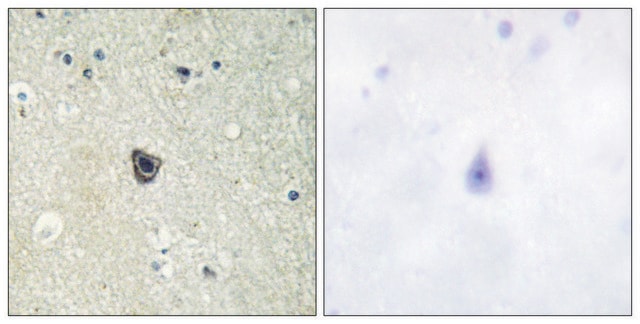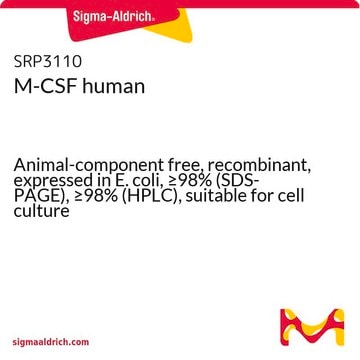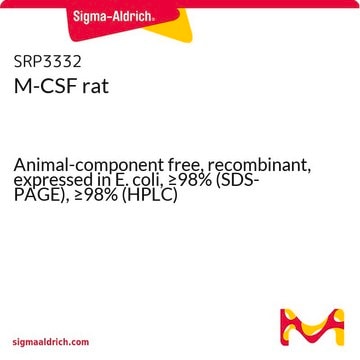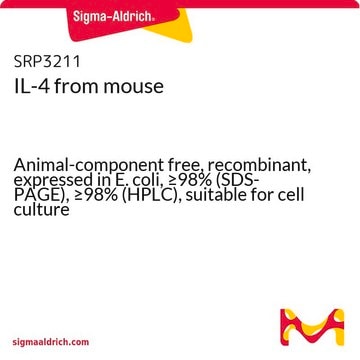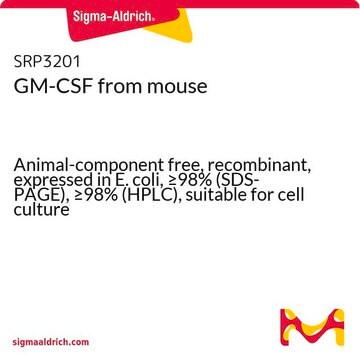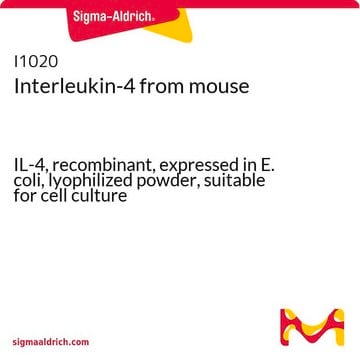M9170
Macrophage Colony-Stimulating Factor from mouse
recombinant, expressed in E. coli, lyophilized powder, suitable for cell culture
Synonim(y):
mCSF-1, mM-CSF, CSF-1, M-CSF
Zaloguj sięWyświetlanie cen organizacyjnych i kontraktowych
About This Item
Numer CAS:
Numer WE:
Numer MDL:
Kod UNSPSC:
12352202
eCl@ss:
32190102
NACRES:
NA.77
Polecane produkty
Szukasz podobnych produktów? Odwiedź Przewodnik dotyczący porównywania produktów
Zastosowanie
Macrophage Colony-Stimulating Factor from mouse has been used:
- in the initiation of osteoclastogenesis in bone marrow monocyte cells
- to stimulate osteoclast differentiation in non-adherent hematopoietic cell
- for the generation of blood-derived stem cells
Działania biochem./fizjol.
Macrophage Colony Stimulating Factor (M-CSF), also known as CSF-1, can be produced by a number of cells, including fibroblasts, monocytes, activated macrophages, secretory epithelial cells of the endometrium, endothelial cells activated by LPS or cytokines, and bone marrow stromal cells. In addition to its namesake activity, M-CSF can stimulate the proliferation of isolated macrophages, augment the production and release of cytokines and other inflammatory modulators from macrophages, enhance macrophage antibody-dependent cell-mediated cytotoxicity, prime and enhance macrophages in their ability to kill tumor cells and other microorganisms, stimulate pinocytosis, and support osteoclast differentiation. M-CSF binds and activates a 165 kDa glycoprotein of the receptor tyrosine kinase subclass III or the RTK subfamily. Due to alternative splicing of a single M-CSF gene and due to variations in glycosylation, the molecular weight of natural soluble M-CSF ranges from 44-86 kDa. Human and mouse M-CSF share approximately 80% sequence homology in the conserved N-terminal region of 150 amino acids. Although human M-CSF is active in murine systems, mouse M-CSF appears to be species-specific in its actions.
Postać fizyczna
Lyophilized from a sterile filtered buffered aqueous solution.
Komentarz do analizy
The proliferative activity is tested by the dose-dependent stimulation of the murine monocytic cell line, M-NFS-60.
This page may contain text that has been machine translated.
Hasło ostrzegawcze
Warning
Zwroty wskazujące rodzaj zagrożenia
Zwroty wskazujące środki ostrożności
Klasyfikacja zagrożeń
Eye Irrit. 2 - Skin Irrit. 2 - STOT SE 3
Kod klasy składowania
11 - Combustible Solids
Klasa zagrożenia wodnego (WGK)
WGK 2
Temperatura zapłonu (°F)
Not applicable
Temperatura zapłonu (°C)
Not applicable
Środki ochrony indywidualnej
dust mask type N95 (US), Eyeshields, Gloves
Certyfikaty analizy (CoA)
Poszukaj Certyfikaty analizy (CoA), wpisując numer partii/serii produktów. Numery serii i partii można znaleźć na etykiecie produktu po słowach „seria” lub „partia”.
Masz już ten produkt?
Dokumenty związane z niedawno zakupionymi produktami zostały zamieszczone w Bibliotece dokumentów.
Klienci oglądali również te produkty
Strain differences in the attenuation of bone accrual in a young growing mouse model of insulin resistance
Rendina-Ruedy E, et al.
Journal of Bone and Mineral Metabolism, 34(4), 380-394 (2016)
Yan Li et al.
Journal of immunology (Baltimore, Md. : 1950), 191(6), 3192-3199 (2013-08-13)
Engraftment of human CD34⁺ hematopoietic stem/progenitor cells into immunodeficient mice leads to robust reconstitution of human T and B cells but not monocytes and macrophages. To identify the cause underlying the poor monocyte and macrophage reconstitution, we analyzed human myeloid
Verena Turco et al.
Nature communications, 14(1), 771-771 (2023-02-12)
Glioblastoma, the most common and aggressive primary brain tumor type, is considered an immunologically "cold" tumor with sparse infiltration by adaptive immune cells. Immunosuppressive tumor-associated myeloid cells are drivers of tumor progression. Therefore, targeting and reprogramming intratumoral myeloid cells is
Monica R P Elmore et al.
Neuron, 82(2), 380-397 (2014-04-20)
The colony-stimulating factor 1 receptor (CSF1R) is a key regulator of myeloid lineage cells. Genetic loss of the CSF1R blocks the normal population of resident microglia in the brain that originates from the yolk sac during early development. However, the
Stephen J Jenkins et al.
The Journal of experimental medicine, 210(11), 2477-2491 (2013-10-09)
Macrophages (MΦs) colonize tissues during inflammation in two distinct ways: recruitment of monocyte precursors and proliferation of resident cells. We recently revealed a major role for IL-4 in the proliferative expansion of resident MΦs during a Th2-biased tissue nematode infection.
Nasz zespół naukowców ma doświadczenie we wszystkich obszarach badań, w tym w naukach przyrodniczych, materiałoznawstwie, syntezie chemicznej, chromatografii, analityce i wielu innych dziedzinach.
Skontaktuj się z zespołem ds. pomocy technicznej